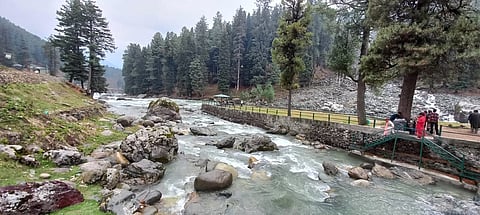Kashmir: The paradise in India where mountains speak in silence
A first-time traveller’s journey through the snow-capped wonders

For Bengalis, the holy grail of travelling to the mountains is to catch a glimpse of Mt Kanchejunga in the Himalayas, be it from Sikkim or Darjeeling in West Bengal. The view, if one is lucky to catch any in the first place – no thanks to the mist and clouds most of the time – is from many miles away. So, when the chance to visit ‘The Paradise on Earth’ came about this month, I couldn’t contain my excitement.
I had never been to Kashmir before, and only saw what it was like in movies and photographs. And from what I had heard, photos and videos don’t do justice to the beauty of the place. I was already transported to another world when I reached Srinagar on April 6 and spent the night in a houseboat on Nigeen Lake, adjacent to the Dal Lake and a less crowded option.
Our next stop was Gulmarg the following day and I got my first glimpse of the western Himalayan range from up close. The snow was still fairly thick on the mountains, on the roads and even on the doorsteps, leaving me completely mesmerised.
That is when my wife, who too had never been to Kashmir before, said, “Wait till you get to Pahalgam”. We reached Pahalgam amidst rain on the evening of April 8 and could only catch a glimpse of the Lidder River gushing down the valley. Next morning, the skies cleared and a stunningly diverse scenario greeted us. The snow-capped mountains were visible on all sides and all around were pine trees, apple orchards and mustard fields. It was a tapestry only nature could conceive.
The place was bustling and buzzing as we stepped out of our hotel to visit what is known as the ABC (Aru Valley, Betaab Valley and Chandanwari) of Pahalgam. Outside were hundreds of ponies and on enquiry, we found that they were waiting to take tourists to the Baisaran Valley, along a narrow path where vehicles couldn’t go.
Our research told us that what we would see at Baisaran would be the same sight as in the other valleys we were off to. We did see the poor ponies trudging along the narrow path with tourists perched on them but thought no more of that place as we went past it to the other spots on our itinerary. Chandanwari of course was the highlight of the triple-header, as we made our second encounter with the snow.
It got colder as we headed higher up the next day to Daksum and then to Sinthan Top, a mountain 12,500ft above sea level, where it snows all year. We returned to the relative warmth of Srinagar on April 11, took in the shikara ride on Dal Lake, visited the Tulip Gardens which only blooms for a month and made the most of the famous Kashmiri hospitality, something that was remarkably warm wherever we went. From treating us to Kahwa (aromatic Kashmiri tea) to being impromptu guides wherever we went, the locals made our stay thoroughly enjoyable.
The only complaint I heard was that they were a bit too persistent in trying to sell their stuff, be it shawls, dried fruits, saffron and what have you. That is when I told my wife, “They have only had small windows of making a living from tourism. Who knows when this one will close?”
Little did I know then how prophetic my words would turn out to be.
Sign up for the Daily Briefing
Get the latest news and updates straight to your inbox



